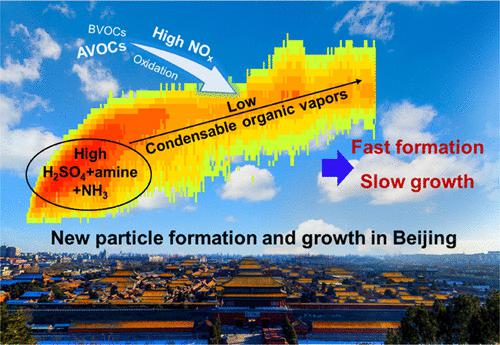当前位置:
X-MOL 学术
›
Environ. Sci. Technol.
›
论文详情
Our official English website, www.x-mol.net, welcomes your feedback! (Note: you will need to create a separate account there.)
Insufficient Condensable Organic Vapors Lead to Slow Growth of New Particles in an Urban Environment
Environmental Science & Technology ( IF 11.4 ) Pub Date : 2022-06-24 , DOI: 10.1021/acs.est.2c01566 Xiaoxiao Li 1 , Yuyang Li 1 , Runlong Cai 2 , Chao Yan 2, 3 , Xiaohui Qiao 1 , Yishuo Guo 3 , Chenjuan Deng 1 , Rujing Yin 1 , Yijing Chen 1 , Yiran Li 1 , Lei Yao 2 , Nina Sarnela 2 , Yusheng Zhang 3 , Tuukka Petäjä 2 , Federico Bianchi 2, 3 , Yongchun Liu 3 , Markku Kulmala 2, 3 , Jiming Hao 1 , James N Smith 4 , Jingkun Jiang 1
Environmental Science & Technology ( IF 11.4 ) Pub Date : 2022-06-24 , DOI: 10.1021/acs.est.2c01566 Xiaoxiao Li 1 , Yuyang Li 1 , Runlong Cai 2 , Chao Yan 2, 3 , Xiaohui Qiao 1 , Yishuo Guo 3 , Chenjuan Deng 1 , Rujing Yin 1 , Yijing Chen 1 , Yiran Li 1 , Lei Yao 2 , Nina Sarnela 2 , Yusheng Zhang 3 , Tuukka Petäjä 2 , Federico Bianchi 2, 3 , Yongchun Liu 3 , Markku Kulmala 2, 3 , Jiming Hao 1 , James N Smith 4 , Jingkun Jiang 1
Affiliation

|
Atmospheric new particle formation significantly affects global climate and air quality after newly formed particles grow above ∼50 nm. In polluted urban atmospheres with 1–3 orders of magnitude higher new particle formation rates than those in clean atmospheres, particle growth rates are comparable or even lower for reasons that were previously unclear. Here, we address the slow growth in urban Beijing with advanced measurements of the size-resolved molecular composition of nanoparticles using the thermal desorption chemical ionization mass spectrometer and the gas precursors using the nitrate CI-APi-ToF. A particle growth model combining condensational growth and particle-phase acid–base chemistry was developed to explore the growth mechanisms. The composition of 8–40 nm particles during new particle formation events in urban Beijing is dominated by organics (∼80%) and sulfate (∼13%), and the remainder is from base compounds, nitrate, and chloride. With the increase in particle sizes, the fraction of sulfate decreases, while that of the slow-desorbed organics, organic acids, and nitrate increases. The simulated size-resolved composition and growth rates are consistent with the measured results in most cases, and they both indicate that the condensational growth of organic vapors and H2SO4 is the major growth pathway and the particle-phase acid–base reactions play a minor role. In comparison to the high concentrations of gaseous sulfuric acid and amines that cause high formation rates, the concentration of condensable organic vapors is comparably lower under the high NOx levels, while those of the relatively high-volatility nitrogen-containing oxidation products are higher. The insufficient condensable organic vapors lead to slow growth, which further causes low survival of the newly formed particles in urban environments. Thus, the low growth rates, to some extent, counteract the impact of the high formation rates on air quality and global climate in urban environments.
更新日期:2022-06-24


























 京公网安备 11010802027423号
京公网安备 11010802027423号